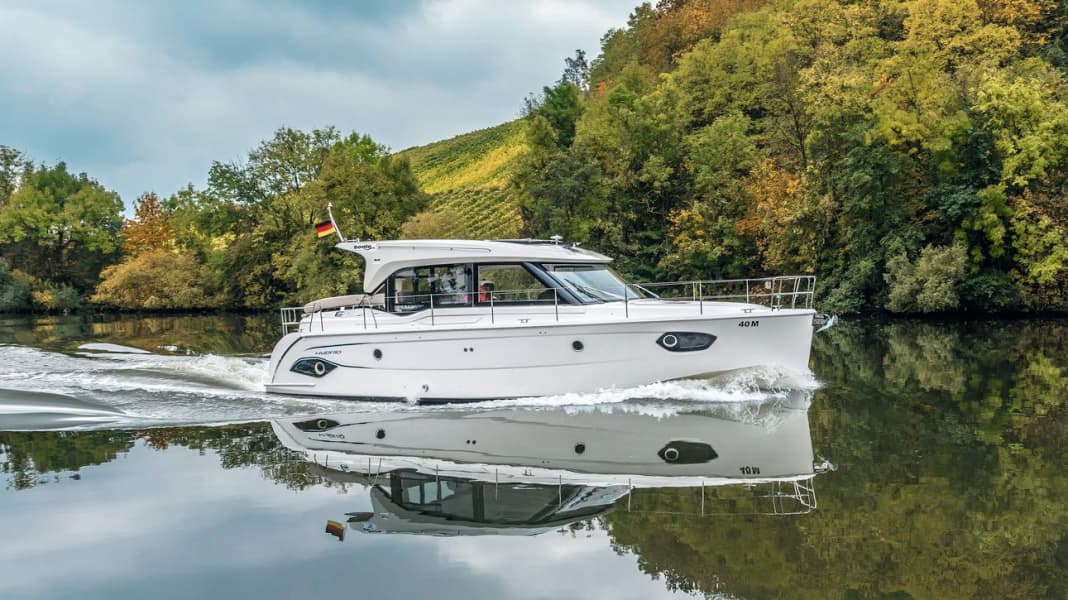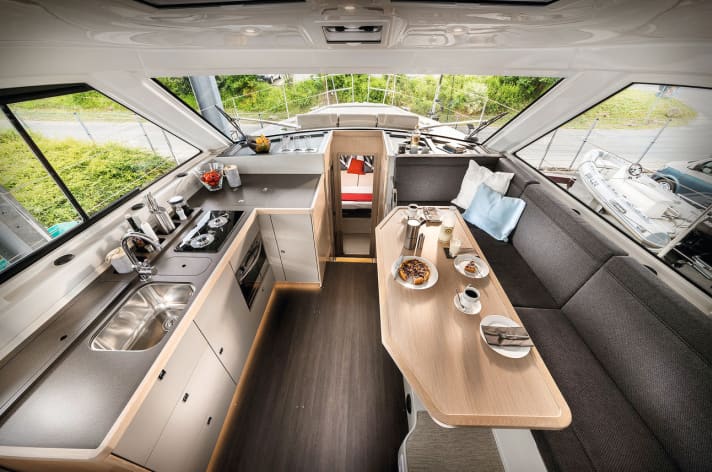Test: Bavaria E 40 - trend setter

When mass production shipyards like Bavaria want to open up new sales markets, they do not do so without a plan. The plan behind the Bavaria E40 presented here is to conquer the inland and touring boat market; the previous Bavaria product portfolio, which consisted exclusively of planing boats, was only suitable for this to a limited extent.
Conventional shaft drive with variable motorisation, a semi-planing hull, space for up to six people and a generous amount of space with a "feel-good character" were the specifications that the designers had to fulfil. We'll come to the E40's highlight, the driving station positioned amidships in the saloon, later.


The catalogue of requirements was based, among other things, on a reader survey conducted by BOOTE, some of the results of which are reflected in this boat. As a so-called "semi-displacement motor yacht", the Bavaria E40 is not designed for maximum speed, but for economy, safety and comfort.
The E of the Bavaria E-Line stands above all for efficiency. Efficiency in terms of the space concept, but also in terms of the drive system. In addition to the standard diesel engines, the E40 can therefore also be ordered in the hybrid version that we tested.
Here, the 150 hp Volvo diesel is supported by a 20 kW electric motor. This also serves as a generator for charging the batteries and transmits its power "in series" with the diesel via the shaft into the water, so that a maximum of 177 hp is theoretically available for propulsion.

We decide on the theoretical hull speed - which is around 7.8 knots - as the optimum cruising speed. For the test boat, 2100 rpm at a speed of just under 8 knots is ideal. With one tank of petrol, the boat can travel 186 nm plus 15% reserve.
If you reduce the engine speed to 1500 rpm, the E40 still reaches 6 kn, while the range increases to a respectable 339 nm plus reserve. At full throttle, we measure a maximum of 9.6 knots, and the theoretical range shrinks to 76 nm (531 nm at slowest speed at 1.62 knots), plus reserve in each case.
Important to know: If the electric motor is engaged as a generator, this reduces the diesel range. For the electric drive itself, the shipyard specifies a journey time of 1.5 hours at 5 knots and 1 hour at 6 knots. Switching from diesel to electric is just as easy with a short time delay as vice versa. That's something.

The driving position is located directly above the engine compartment, yet the sound pressure we measured remains surprisingly low at 75 db(A). The manoeuvring behaviour of the Bavaria E40 can be described as "displacement-typical". As is usual with this type of boat, the direction of rotation of the propeller determines which side of the boat is the best when mooring and casting off, and with a single engine, the bow thruster is a must in order to counter wind or currents from the side.
The straight-line stability is fine, although the skipper has to intervene from time to time via the large steering wheel, which is reminiscent of a sailing boat. The positioning of the driving position at the rear end of the saloon provides an unprecedented feeling of space and integrates the driver into life on board, but this arrangement is disadvantageous in the dark.
During our test night drive on the Main, it turned out that any light source in the saloon irritates the driver's eye. In plain language: if you want to travel at night, you have to switch off all light sources in the saloon, including the instrumentation. Only when we go to the front, where the driving position is usually located, does the strain subside and the eyes relax with good foresight.

By day, things look different in the truest sense of the word. The skipper has an almost uninterrupted all-round view and sits in the centre of the action - a completely new feeling for motorboat drivers. If it rains, large wipers on the windscreen create a clear field of vision, and defroster nozzles in the interior dry the windows in high humidity.
In terms of workmanship, the test boat was not entirely convincing, as is usual with a build number one. Untreated cut edges at bulkhead openings, where hoses and cables can rub, should be eliminated in series production.

The engine compartment is large enough; despite the additional electric drive, it is easy to manoeuvre. On deck, you can access the foredeck via side decks with a wide coaming. We don't like the wire rope railing that runs right up to the pulpit. A stable, all-round tubular railing would be better here - as is usual on other Bavaria yachts. Otherwise, everything in and on the boat fits, as you would expect from the shipyard.
An interesting feature is the manually fold-out bathing platform, which extends the E40 carpool's radius of action, especially when at anchor. The room layout is generous for a 40-foot boat. The galley integrated in the saloon on the port side and the helm station also located in the saloon make the Bavaria E40 a real trendsetter in terms of cruising boats. It is available as a flybridge version or in the test version with the designation Sedan. Other models in the E series are in preparation.
Conclusion:
With the E40, the shipyard is breaking new ground, especially in the hybrid version. The driving characteristics are good-natured, typical of displacement boats, and the space concept is interesting for families. However, we were not convinced by the driving position, especially when travelling at night.
This article is from the July 2017 issue of BOOTE.

